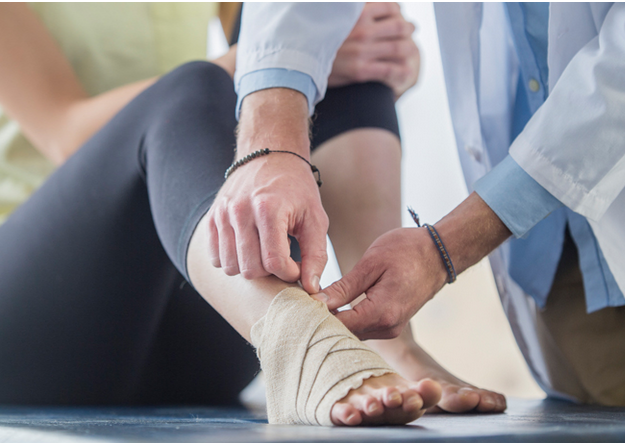Diagnosis and Treatment of Lisfranc Injury in Wake County

What is a Lisfranc Injury?
A Lisfranc injury occurs when you sprain, fracture, or dislocate ligaments or bones in the Lisfranc joint complex. The Lisfranc joint complex connects your midfoot with your forefoot. In other words, it connects your metatarsal bones with the cuboid bone and the three cuneiform bones (lateral, middle, and medial) of your midfoot.

Causes of Lisfranc Injuries
Lisfranc injuries are often associated with trauma. Trauma in high-impact activities such as sports, car accidents, or falls that place a great deal of force on the foot can all cause a Lisfranc injury.
Lisfranc Injury Risk Factors
Risk factors for Lisfranc injuries include participating in sports that require a lot of movement and twisting forces on the foot. Sports that have a higher incidence of Lisfranc injuries include football and soccer.
Symptoms of a Lisfranc Injury
An individual with Lisfranc injury may experience the following symptoms. The symptoms listed below should prompt you to schedule an appointment with an orthopedic specialist.
- Swelling located at the top of the foot
- Pain in the midfoot that causes issues with weight bearing and worsens while standing
- Walking or pushing off the foot
- Bruising on the top and bottom of the foot.
How is a Lisfranc Injury Diagnosed?
After talking to your doctor about your medical history, your symptoms, and the nature of your injury, they will perform a physical examination of your foot. The exam may include a visual examination to check for bruising along the bottom of your foot, which points to a Lisfranc ligament tear. Then, they will most likely test for pain in your midfoot by palpating it, twisting your heel, and/or performing a test in which they manipulate your toes up and down. If a Lisfranc injury is present, you will experience pain in the midfoot with these movements. Your doctor may also ask you to do a calf raise on your injured foot, which may show weakness in the injured foot in the case of a Lisfranc injury that is harder to detect via other methods.
Imaging tests such as X-rays, MRIs, and CT scans may be performed to help the doctor diagnose the type or severity of your Lisfranc injury. X-rays will show breaks, fractures, and alignment issues. MRIs can show Lisfranc injuries that are more difficult to diagnose with an X-ray. CT scans may be required if your doctor wants a more detailed picture of the Lisfranc injury prior to surgical intervention.

Treatment Options for Lisfranc Injuries at Raleigh Orthopaedic
A Lisfranc Injury may be treated surgically or nonsurgically, depending on the severity of the injury.
If you have not broken or fractured any bones, or completely torn or dislocated any ligaments or bones, you may simply need to wear a boot for six to eight weeks in order to help the partial tear (sprain) heal. After this period of recovery, you will work with a physical therapist to gradually recover your strength and get back to your normal daily activities.
If you have suffered a dislocation, fracture, or full tear of one of the Lisfranc ligaments, surgery will likely be required in order to ensure that the bones of your midfoot are correctly aligned. You may need screws or metal plates to keep the bones in place to allow them to heal. You will have to wear a boot or cast for three months after surgery and perform a physical therapy regimen to get you back to your daily activities. In some cases, since the Lisfranc joint moves very little, your surgeon may fuse your midfoot bones instead of fixing them in place with screws. This may be an option for pain reduction depending on your injury.

Lisfranc Injury Recovery Time
Recovery from a Lisfranc injury depends on the treatment required. After surgical intervention, you may not be able to walk for up to 8 weeks while you heal. Full recovery after surgery may take 6 months to a year. Nonsurgical intervention may require you to wear a boot for up to eight weeks, after which you will perform physical therapy to help you recover fully.
How Can I Prevent a Lisfranc Injury?
It is not always possible to prevent Lisfranc injuries, but wearing appropriate footwear, working on your balance, and making sure your living space is easy to navigate may help you to prevent such injuries.

Expert Foot and Ankle Care at Raleigh Orthopaedic
For over 100 years, we have served patients in Wake County and provided the highest level of orthopedic care. We work with patients of all ages to diagnose and treat all manner of orthopedic injuries, including Lisfranc injuries – helping them to live and move more comfortably each day. If you are looking to meet with one of our orthopedic specialists in NC, give us a call or book an appointment online today.




